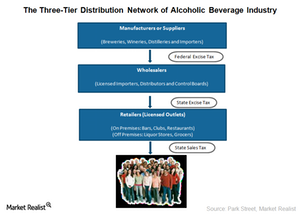The Three-Tier Distribution of the US Alcoholic Beverage Industry
The three-tier distribution system ensures collection of taxes and prevents control of production, distribution, and selling by a single entity.
Mar. 30 2015, Updated 1:05 p.m. ET

Purpose of the distribution system
The three-tier distribution system for the US alcoholic beverage industry was implemented following the repeal of Prohibition in 1933. The purpose of this distribution system is to ensure proper collection of taxes and prevent the control of production, distribution, and selling of alcoholic beverages by a single entity.
Three-tier distribution system
The first tier of the three-tier distribution system involves manufacturers or suppliers of alcoholic beverages such as breweries, wineries, distilleries, and entities that have contracts with manufacturers.
The manufacturers can sell their beverages to wholesalers, who form the second tier of the distribution system. Wholesalers can be licensed importers, distributors, or control boards. The wholesalers then sell beverages to retailers, who further sell them to consumers. Retailers include on-premises entities such as bars and clubs, as well as off-premises entities like liquor stores and grocers. About 32 states in the United States follow this system. They’re called open states.
Manufacturers like Constellation Brands (STZ), Brown Forman (BF.B), and Molson Coors Brewing (TAP) together make about 3.34% and 0.24% of the Consumer Staples Select Sector SPDR Fund (XLP) and the SPDR S&P 500 ETF (SPY), respectively. The Vanguard FTSE All-World ex-US ETF (VEU) has 1.17% exposure to Diageo (DEO) (DGE.L). The iShares Core S&P 500 ETF (IVV) allocates ~9.59% of its holdings to the consumer staples sector, which includes beverage companies.
Exceptions to three-tier distribution
There are 18 US states, including Washington, Oregon, Utah, and Pennsylvania, that don’t follow the three-tier distribution system. These states, called the control states, can excise a monopoly by taking control of the distribution or retailing, or both, of the alcoholic beverages.
What do the critics say?
The three-tier distribution system has helped make the alcoholic beverage industry more organized. It has prevented illegal manufacturing and distribution as well as monopolies by large players. However, critics believe the system has resulted in consumers paying a higher price due to the margins and taxes involved at each tier of the distribution system.
